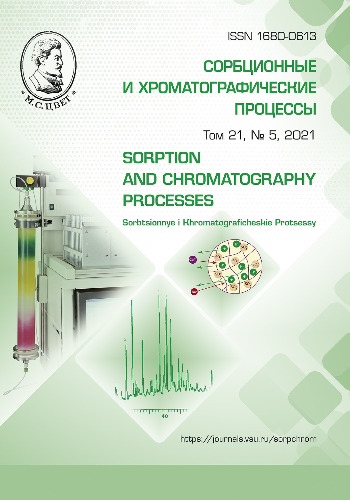Structure and sorption properties of mesoporous silica synthesised using a varying temperature and silicon source
Abstract
Ordered mesoporous silica can be used as efficient adsorbents for the separation and purification of substances of different polarity. It is known that such materials can selectively sorb α-tocopherol and β-carotene. However, it is necessary to select the optimal sorbent synthesis conditions to achieve maximum process efficiency. There are many studies examining changes in structural characteristics depending on the synthesis conditions. However, the correlation between the conditions and sorption properties is poorly studied. The purpose of the work was to study the structural and sorption properties of nanostructured analogues of SBA-15 varying the temperature and source of silicon oxide.
Silica was obtained by sol-gel synthesis with hydrothermal treatment in a reaction mixture including a colloidal Ludox HS-40 silicate solution or tetraethoxysilane as the silicon oxide source, Pluronic P123, HCl, and H2O. The structure of the synthesised materials was analysed by low-temperature nitrogen adsorption/desorption and IR spectroscopy. We studied the temperature-dependent formation of micelles of the Pluronic P123 triblock copolymer using dynamic light scattering.
The dependence of the micelle formation of the triblock copolymer on the synthesis temperature is the main evidence of the influence of temperature on the properties of silica. When synthesised from tetraethoxysilane at temperatures above 21°C, materials with an ordered structure were formed, as a hexagonal pattern phase was formed under these conditions. However, when we used Ludox HS-40 as the source of silicon oxide, we did not manage to obtain materials with a similar structure, as a change in the acidity of the medium was required.
We studied the sorption of α-tocopherol and β-carotene by the synthesised materials under static conditions. The sorption properties of silica were matched with their structure and the origin of the sorption centres. We determined that the amount of the sorbed matter was higher for materials with a larger surface area and a highly ordered structure.
Downloads
References
Beck J.S., Vartuli J.C., Roth W.J., Le-onowicz M.E. et al., J. Am. Chem. Soc., 1992, Vol. 114, pp. 10834-10843.
Yanagisawa T., Shimizu T., Kuroda K., Kato C., Bull. Chem. Soc. Jpn., 1990, Vol. 63, pp. 988-992.
Li G., Wang B., Wang Z., Li Z. et al., J. Phys. Chem. C, 2018, Vol. 122(35), pp. 20210-20231.
Gamero-Quijano A., Karman C., Vila N., Herzog G. et al., Langmuir, 2017, Vol. 33, pp. 4224-4234.
Deng X., Schmidt W., Tüysüz H., Chem-istry of Material, 2014, Vol. 26, No 21, pp. 6127-6134.
Yilmaz M. S., Palantoken A., Piskin S., Journal of Non-Crystalline Solids, 2016, Vol. 437, pp. 80-86.
Basak. R., Bandyopadhyay R., Lang-muir, 2013, Vol. 29, pp. 4350-4356.
Emparan-Legaspi M.J., Gonzalez J., Gonzalez-Carrillo G., Ceballos-Magana S.G. et al., Microporous and Mesoporous Mate-rials, 2020, Vol. 294, pp. 109942-109950.
Hafezian S.M., Azizi S.N., Biparva P., Bekhradnia A., Journal of Chromatography B, 2019, Vol. 1108, pp. 1-10.
Dua L.-J., Yi L., Ye L.-H., Chen Y.-B. et al., Journal of Chromatography A, 2018, Vol. 1537, pp. 10-20.
Kim J., Desch R.J., Thiel S.W., Gu-liants V.V. et al., Microporous and Mesopo-rous Materials, 2012, Vol. 149, pp. 60-68.
Zhao D., Feng G., Huo Q., Melosh N. et al., Science, 1998, Vol. 279, pp. 548-552.
Krizhanovskaya О.О., Sinyaeva L.A., Karpov S.I., Selemenev V.F. et al., Sorbtsionnye i khromatograficheskiye protsessy, 2014, Vol. 14, No 5, pp. 784-794.
Krizhanovskaya О.О., Borodina E.V., Karpov S.I., Selemenev V.F. et al., Sorbtsionnye i khromatograficheskiye protsessy, 2012, Vol. 12, No 4, pp. 583-591.
Chandrasekar G., Vinu A., Murugesan V., Hartmann M., Studies in Sur-face Science and Catalysis, 2005, Vol. 158, pp. 1169-1176.
Kohno Y., Kato Y., Shibata M., Fu-kuhara C. et al., Microporous and Mesopo-rous Materials, 2016, Vol. 220, pp. 1-6.
Korzeniowska A., Strzempek W., Makowski W., Menaszek E. et al., Mi-croporous and Mesoporous Materials, 2020, Vol. 294, pp. 109903-109910.
Branton P.J., Hall P.G., Sing K.S.W., Adsorption, 1994, Vol. 1, pp. 77-81.
Thommes M., Kaneko K., Neimark A.V., Olivier J.P. et al., J. Pure Appl. Chem., 2015, Vol. 87(9-10), pp. 1051-1069.
Wanka G., Hoffmann H., Ulbricht W., Macromolecules, 1994, Vol. 27, pp. 4145-4159.
Groen J.C., Peffer L.A.A., Perez-Ramırez J., Microporous and Mesoporous Materials, 2003, Vol. 60, pp. 1-17.
Choma J., Jaroniec M., Applied Sur-face Science, 2007, Vol. 253, pp. 5587-5590.
Boyd I.W., Appl. Phys. Lett., 1987, Vol. 51, pp. 418-421.
Monash P., Pugazhenthin G., Korean J. Chem. Eng., 2010, Vol. 27, No 4, pp. 1184-1191.
Dailey J.S., Pinnavaia T.J., Chem. Mater., 1992, Vol. 4, pp. 855-863.
Zhao X.S., Lu G.Q., Whittaker A.K., Millar G.J. et at, J. Phys. Chem. B, 1997, Vol. 101, No 33, pp. 6525-6531.
Almeida R.M., Pantano C.G., J. Appl. Phys., 1990, Vol. 68, No 8, pp. 4225-4232.
Almeida R.M., Marques A.C. Charac-terization of Sol-Gel Materials by Infrared Spectroscopy. In: Klein L., Aparicio M., Jiti-anu A. (eds) Handbook of Sol-Gel Science and Technology. Springer, Cham, 2018, pp.1122-1134.
Karpov S.I., Roessner F., Selemenev V.F., Nechaeva L.S. et al., Sorbtsionnye i khromatograficheskiye protsessy, 2013, Vol. 13, No 3, pp. 273-283







